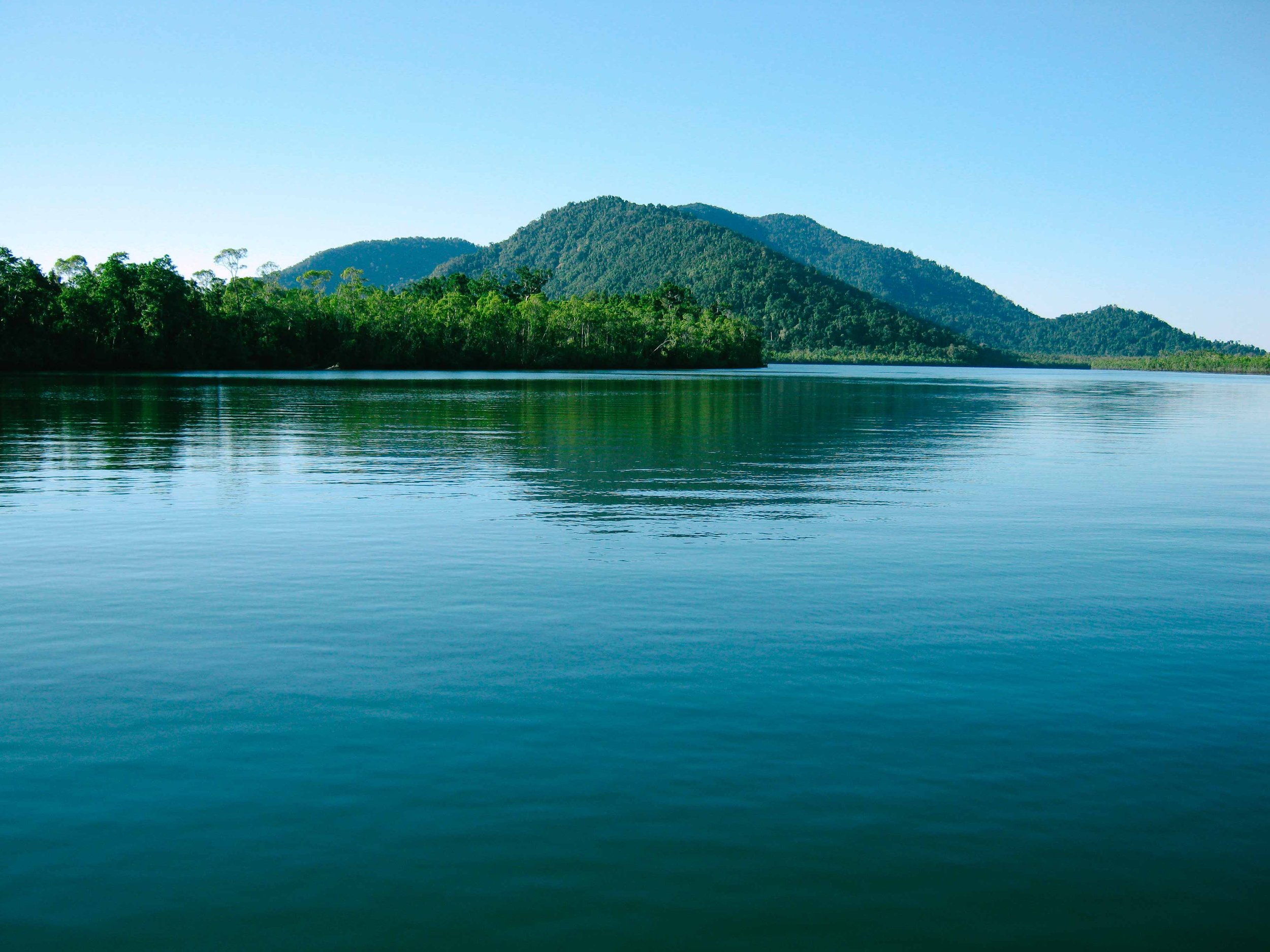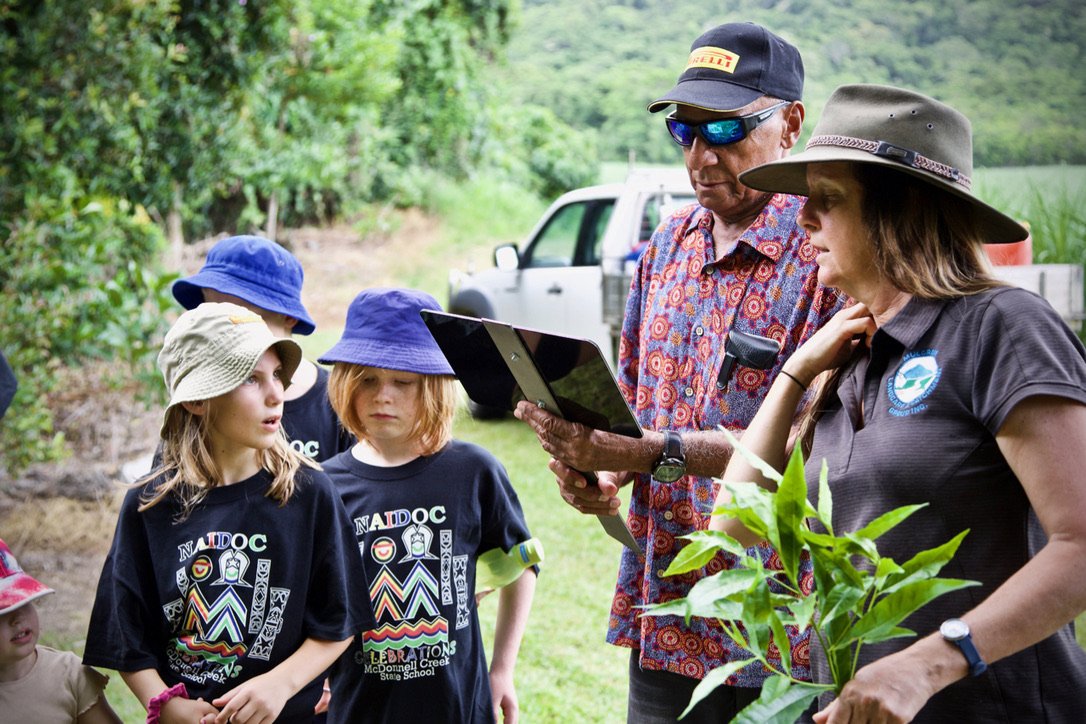Our Country
‘Country’ describes the complex layers of meaning associated with our place of origin and belonging, it’s our home, culture, language, identity, values, and knowledge. Country links the past and present, because of this richness and our deep connection with Country we feel and care for Country as we do for each other.
MadjayBana
The waters belogning to the Madjandji people.
Madjay - the Madjandji dialect
Bana - means water
Our People
Madjandji people were the earliest custodians of this area, the land and waters were our cultural and life supporting homeland that had always been part of our spiritual Dreamtime.
Madjandji People
Near Babinda 1893
Our Ancestral Estate
Wanyurr-Madjay hold a successful native title determination to portions of the Wooroonooran National Parks (North East Queensland), and are the traditional owners of the of the country stretching outwards from the native title determined lands, including all the waters flowing from the native title determined lands, with waters flowing and country stretching out into the lower Russell-Mulgrave Rivers, and outwards into the Great Barrier Reef lagoon, with Palmer Point along the coast to the north, and Cooper Point along the coast to the South.
MadjayBana
The MadjayBana estate extends upstream until the saltwater becomes fresh water.
Maps of our traditional Madjandji Estate
Map of Wanyurr-Majay Native Title Determined area.
Aerial map of Wanyurr-Majay
land and waters.
Topographic map of Wanyurr Majay Regional Ecosystem.
Threats, actions, recommendations & monitoring to preserve & restore land.
Habitat loss
Encroaching urban development and agriculture has placed stress on the natural environment in our region.
Action
To continue funding, support and expand our Indigenous Ranger Program to ensure the development and implementation of our project management plan to care for all of Traditional Gulgibara land and waters including currently unmanaged lagoons, swamps, wells, waters, shores and significant coastal lowland ecosystems from Palmer to Coopers Point, cleaning and restoring fresh waters, monitoring usage, visitor management and controlling pest plant and animal species.
Action
WMAC is working closely with landholders, NRM groups and Government bodies to restore degraded land, boost biodiversity, and promote well-being.
Re-vegetation of degraded farmland adjoining Mulgrave River at Deeral is well underway, and further projects are about to commence further upstream. Our Madjaybana Ranger team is working with Dept of Resources, Cairns Regional Council and Terrain to repair the littoral rainforest on a coastal stretch of land in Woolanmaroo. WMAC members and directors have also assisted landholders in the Babinda area restore vegetation along creek banks to improve wildlife corridors and reduce erosion.
Our land restoration projects have been funded by the Great Barrier Reef Foundation, the Department of Environment and Science, the Department of Resources, Terrain, Missionary Sisters of Service, and Greening Australia.
Habitat Maintenance
There is an urgent need act now to protect important intact natural ecosystems.
Ecologist Peter Stanton highlighted the high conservation significance and the need for appropriate fire regime for maintenance of the sclerophyll habitats of Woolanmaroo:
Woolanmaroo once supplied TO’s with an abundance of Minya & Mayi. Endangered iconic species such as the Cassowary and Spectacled Flying Fox are still present on the site. Russell Heads residents have spotted cassowaries swimming from the North Shore to the southern bank. Cassowary scats & footprints have also been sited on our large scale re-veg projects at Deeral.
Action
Our Madjaybana Ranger team is working with Dept of Resources, Cairns Regional Council and Terrain to repair and maintain the littoral rainforest on a coastal stretch of land in Woolanmaroo, by removing pest plant species, planting native endemic plants, and conducting a cultural burn.
The removal of introduced plant species is planned to assist in to restoring the natural habitat, help prevent the loss of cassowary habitat and improve the visual amenity of the area. The area will also be assessed for soil and vegetation loss caused by severe weather events and storm tidal surges. The extent of rubbish and marine debris spoiling the natural habitat will be recorded and shared with Tangoroa Blue, pest animal and insect species (e.g., Yellow Crazy Ants, Asian honeybee, feral pigs, etc) will be noted and reported to authorities.
Action
Madjaybana Rangers have received Cultural Burning training and qualifications with Fireground Leadership and Training. Cultural burns have been conducted at Deeral, with another planned for Woolanmaroo.
Action
Madjaybana Rangers are enrolled and have commenced on CEM training with Jenegar.
Monitoring
Birdlife Australia has conducted surveys at the Deeral projects, to identify and record the number of bird species attracted to the site, the report also recommends plant species for inclusion in future re-vegetation.
Bird populations of the Ross Road property, Deeral Queensland.
Baseline data for the Woolanmaroo project scheduled to be collected in April by Terrain and the Ranger team, photographic and video records have commenced.
Video of re-vegetation site, courtesy Franco Arri.
Our Water
Waters from our existing Wanyurr-Majay native title determined lands flow into the Mulgrave -Russell River catchment, Great Barrier Reef Lagoon and Frankland Islands, all of which being waters of particular concern to our people. Wanyurr-Majay wish to play a significant role culturally informing, engaging, building partnerships, and participating in combined efforts to improve overall water quality.
Madjaybana is the traditional name for the saltwater reaches of the Mulgrave and Russell rivers. (Madjay is the Madjandji dialect and bana means water)
The traditional name for the lower reaches of the Mulgrave River is Gulugulubana meaning black bream waters
Gulugulubana
The Mulgrave and Russell Rivers Confluence. Photograph courtesy Terrain NRM
Threats, actions, recommendations & monitoring for all of Madjandji waters.
Loss of riparian vegetation including mangroves
Action
CAFNEC have partnered with WMAC to monitor mangroves, riverbank and general river conditions in the lower Mulgrave and Russell Rivers, the data collected is used to prepare reports and to give leverage for future funding, management plans and actions. WMAC are involved in developing and delivering an education program to better inform school students about the value of mangrove ecosystems. The (LAP) local area program will be launched at McDonnell State School because of its close location to the Mulgrave and Russell Rivers and extended to other schools in the future.
Mangrove watch on the Russell River & Local area planning.
Over visitation leading to illegal dumping of rubbish & erosion
Action
Over visitation is resulting in illegal dumping of rubbish, and river and creek bank erosion. The Great Barrier Reef Foundation has funded a Madjandji Healing Waters Report Card, which will record and make recommendations to deal with problems arising from over-visitation.
Water security
Action
Cairns Water Security Stage 1 Project – Endorsement WMAC for involvement in Cultural Heritage Management Plan development
Cairns Regional Council and Wanyurr-Majay Aboriginal Corporation RNTBC are working together in developing the Cultural Heritage Management Plan (CHMP) for the first stages of Council's Cairns Water Security Stage 1 Project
In accordance with the requirements of the Aboriginal Cultural Heritage Act 2003 (Qld), the Cairns Regional Council hereby endorse WMAC as an Aboriginal party to take part in developing the CHMP.
Signage is being prepared for installation at the boat ramps to educate the public.
Monitoring water quality
Madjaybana rangers have received in-kind training from Dept of Environment & Science and Mulgrave Landcare to record, collect, and preserve water samples for scientific and eDNA analysis. Samples collected are tested for nutrient, sediment pesticides, and DNA. Data collected is to be shared with relevant interested partners.
Water sampling training with Dept. Environment & Science.
Madjaybana rangers water sampling.
Water monitoring to record cultural values & scientific data to determine water quality
In delivering the “Madjandji Healing Waters Project” Madjaybana Rangers will work closely with the Great Barrier Reef Foundation Russell/Mulgrave Water Quality Project to ensure the program delivers culturally component water quality outcomes that meet the aspirations of Wanyurr-Majay peoples to heal Country. We will be working with professionals from Farmacist and James Cook University to produce a targeted action plan and report on significant Bana sites and will work with JCU and landholders on riparian, wetland rehabilitation and revegetation projects.
Madjandji people have lifetimes of practical traditional ecological knowledge of the water based minya (fauna) and mayi (flora) of Madjaybana and Gulgulubana waters, seasonal/ecological knowledge of local species will to be more systematically used in partnership with data co-produced with an amazing set of partners to supplement, enhance, and better monitor, measure, and manage the water quality and health of Madjaybana & Gulgulubana.
Our Culture
Our Cultural identity is linked to our ancestors, our language, knowledge, rituals, stories, and deep connection with Country.
Madjandji
Photograph taken by A.A White in 1904 from Mud Island, which once existed in Mutchero inlet.
Photograph courtesy John Oxley Library.
Threats, actions, recommendations & monitoring to preserve & revive Culture.
To rebuild, relearn, and revive our ancestral language
Action
Language revival: Madjandji families are continuing to work with our Elders, Emerging Elders, digital designer, recording studio and our own artist, to together rebuild, relearn, and revive our ancestral language, and create quality learning resources. Funding for language projects received from DATSIP and Department of Infrastructure, Transport, Regional Development and Communications.
Elders learn language.
Director and Emerging Elder Nathan Broom takes the lead at the language workshop.
Director Clive Murray teaches language to students.
To re-find, re-walk, record, map ancestral walking tracks
Action
Madjaybana Rangers have commenced the Dept. of Environment and Science funded project to locate ancestral walking track going over and through the southern portion of the Malbon-Thompson Forest Reserve (clear of, and without crossing into any existing native title determined areas] reconnecting Deeral and Aloomba to the coast at least, if not Yarrabah in the long run.
Map of old logging trails which followed walking tracks in Woolanmaroo area.
Recording of cultural sites
Action
WMAC has appointed an Elders’ steering committee, a technical support team, and established a ranger team to map and promote the spiritual, traditional, and cultural values and knowledge of Country.
Cultural mapping of our culturally significant waters has commenced in partnership with Cairns Regional Council, Department of Resources, Queensland Parks & Wildlife Service and Farmacist.
Sites of cultural significance.
Gulugulubana
Members have fun Cultural Mapping Gulugulubana
Documenting stories
Action
Workshops are ongoing giving Elders the opportunity to recall, write stories. Stories to be recited and recorded.
Cecilia shares her story
Truth telling
Action
A lack of a shared understanding of our history both within the indigenous and broadercommunity is of concern and a roadblock to healing and reconciliation. Madjandji Elders and corporation members share a mission to progress truth-telling and share the Madjandji story to promote acceptance and empathy.
Funding has been received under the Celebrating Reconciliation Grant for the delivery of Madjandji Truth Telling.
Promote Cultural Awareness
Action
NAIDOC has always provided a platform to share our Culture with the broader community. Past activities have included the establishment of a bush tucker plot at the local school, Cultural art activities and language learning for students, and Elders storytelling.
NAIDOC
Preparing for the bush tucker plot with Landcare Lisa & Clive Murray.


























